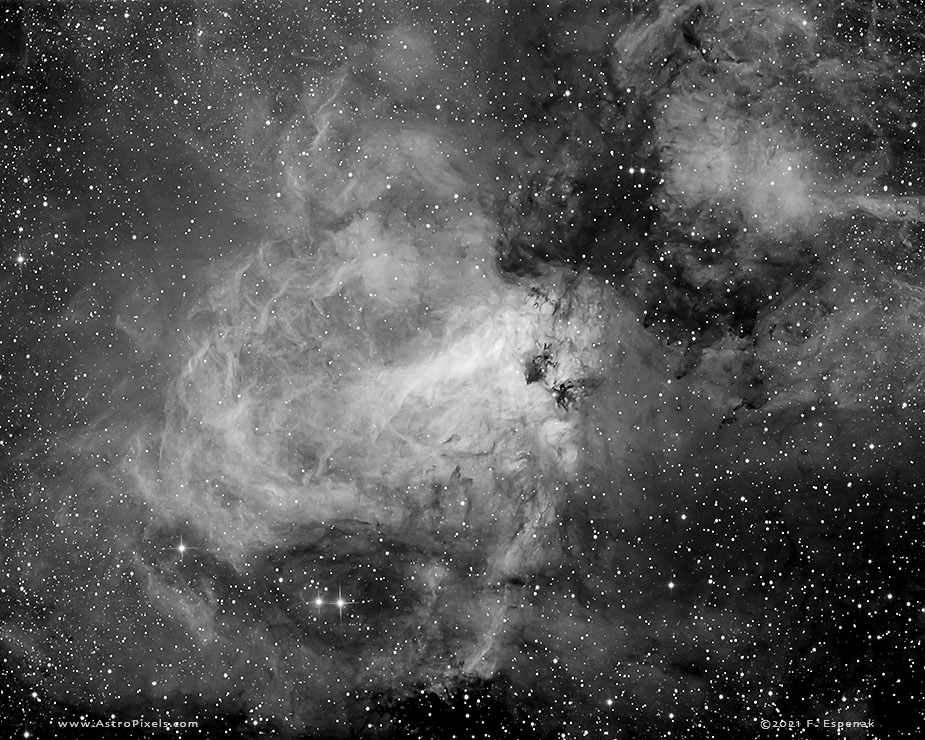M17 - Omega Nebula (NGC 6618)
The monochromatic image above shows M17 as shot through a Hydrogen Alpha filter.
Messier 17 or M17 (also designated NGC 6618) is a nebula and star cluster in the constellation Sagittarius. It has an apparent visual magnitude of 7 and its angular diameter is 11 arc-minutes. M17 lies at an estimated distance of 5000 light years. The Equinox 2000 coordinates are RA= 18h 20.8m, Dec= -16° 11´ which makes M17 best seen during the summer. The Messier Summer Star Chart shows the position of all Messier objects visible during that season. As one of the more famous objects in the Messier Catalog, it is commonly known as the Omega, Swan, or Checkmark Nebula.
In spite of its inclusion in the Messier Catalog, this nebula and star cluster were actually discovered by J-P. de Chéseaux in 1746. The Omega Nebula is a region of active star formation. Its glowing hydrogen gas is due to excitation from ultraviolet radiation emitted by hot young stars embedded in the nebula. According to Kharchenko et al. (2005), the distance of M17 is 5910 light years and its diameter is 10 light years. It contains 2200 stars and its estimated age is 1 million years.
For more information, see the Messier Catalog as well as specific entries for M17 in Wikipedia and SEDS.
Messier's Description of M17
June 3, 1764
`A train of light without stars, of 5 or 6 minutes in extent, in the shape of a
spindle, and a little like that in Andromeda's belt [M31]
but of a very faint light; there are two telescopic stars nearby and placed
parallel to the equator. In a good sky one observes this nebula very well in an
simple refractor of 3.5 feet. Reviewed on March 22, 1781.'
(diam. 5')
Technical Details
- Object: M17 - Omega Nebula
- Other Names: NGC 6618, Omega, Swan, or Checkmark Nebula
- Object Type: nebula and star cluster
- Object Data: Apparent Magnitude = 7, Angular Size = 11 arc-minutes
- Object Position (Equinox 2000): RA= 18h 20.8m, Dec= -16° 11´, Constellation = Sagittarius
- Date: 2021 Jul 26-28 (3 nights)
- Location: Chile Remote Observatory, Observatorio El Sauce, Chile
- Partnership: Operated in partnership with David Churchill
- Telescope: Planewave CDK-17 (with Focal Reducer: f/4.5; FL = 1945mm)
- Camera: QHY 16200A with Integral 7-position Filter Wheel
- Mount: Astro-Physics 1600GTO
- Guider: Agena Starguide II / SBIG STi
- Sub-Exposures: Astronomik Filters
- H-Alpha: 70 x 10 min = 700 min - Total Exposure: 11h 40m
- File Name: M17-CDK21Ha-C02w.jpg
- Field of View: 38.9' x 58.3' at 0.64 arc-sec/pixel
- Original Image Size: 3630 x 4540 pixels (16.5 MP); 12.1" x 15.1" @ 300 dpi
- Data Acquisition: David Churchill
- Image Processing: Fred Espenak
- Maxim DL: Image Calibration, Stacking, Log Stretch
- Adobe Camera Raw: Noise Reduction, Color/Contrast Adjustments
- Photoshop CC: Curves, Levels, Hi Pass Filter
- Topaz Labs: Sharpen AI - Copyright: Fred Espenak
